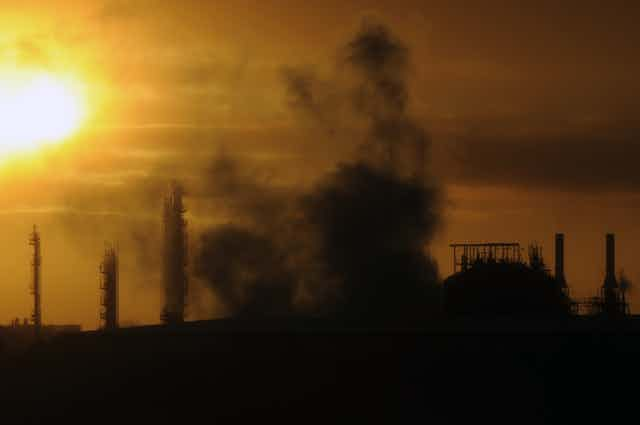Australia is holding its collective breath ahead of a bushfire season that may bring a return of the smoke linked to 400 deaths and 4,500 hospitalisations and emergency department visits during the 2019–20 Black Summer fires.
Air pollution is the world’s single greatest environmental cause of preventable disease and premature death. In Australia, it’s linked to more than 3,200 deaths a year at an estimated cost of A$6.2 billion.
These impacts are increasing due to climate change and an ageing population, among other factors. Scientists at the Centre for Safe Air (an NHMRC Centre for Research Excellence) have launched a report today on the many benefits of safer air for Australians, to mark the United Nations’ International Day of Clean Air.
The report summarises the extensive evidence on the health impacts of air pollution for Australians. This pollution consists of both airborne particles (also called particulate matter) and gases such as carbon monoxide, nitrogen dioxide and sulphur dioxide. The report also explains why co-ordinated national leadership is needed to make our air safer.
Read more: Air pollution: most national limits are unsafe for human health – new WHO guidelines
Why invest in clean air?
Here are ten reasons Australia should invest in safer air.
1. Air pollution increases non-communicable diseases
Heart disease, stroke, dementia, type 2 diabetes, lung diseases and cancer are all leading causes of illness and death for Australians. Air pollution increases the risk of all these conditions in the community.
2. Air pollution makes communicable diseases worse
Air pollution increases the risk of respiratory infections such as influenza and COVID-19, and may increase their severity.
3. Air quality affects our health throughout life
Air pollution can affect the growth, development and overall health of unborn babies. Later in life it adds to the risk of developing non-communicable diseases.
4. It adds to health inequities
Action on air pollution represents a powerful opportunity to reduce health inequities in Australia. Some of the most vulnerable people in our society are at higher risk of worse health outcomes from air pollution exposure. They include older adults, pregnant people and unborn babies, children, people with pre-existing chronic conditions, socially disadvantaged populations and Aboriginal and Torres Strait Islander people. Lessening air pollution reduces inequity.
5. Climate change and pollution make each other worse
Climate change is leading to more frequent and severe bushfires. In turn, severe bushfires are influencing the global climate and weather systems. Reducing air pollution is vital for mitigating climate change because they share common drivers such as fuel combustion.
Read more: Wildfire smoke and dirty air are also climate change problems: Solutions for a world on fire
6. Clean-air policies have many co-benefits
Policies to reduce air pollution from burning fossil fuels have many health, environmental and social benefits. Measures range from decarbonising our energy and transport systems, greening our cities and improving urban and housing design to bushfire prevention strategies. Reducing air pollution improves social, environmental and economic wellbeing.
7. The impacts are increasing
Population growth and ageing, urbanisation and increasing transport and energy demands add to the risks for air quality, climate change and population health. This is why timely interventions are needed.
8. Economic costs are high and underestimated
Australian estimates to date have placed annual mortality costs of fine particulate matter (PM2.5) air pollution at A$6.2 billion. However, existing economic analyses of air pollution largely fail to account for the costs of other air pollutants, such as nitrogen dioxide from vehicle traffic, and non-health costs like labour, productivity, welfare and other societal impacts.
Read more: Air quality near busy Australian roads up to 10 times worse than official figures
9. Return on investment is high
Every dollar spent generates returns in the forms of lower health costs, healthier people and longer lives. Soon-to-be-published research at the Centre for Safe Air has found reducing the average population exposure to fine airborne particles (PM2.5) by a modest and highly achievable 5% could save more than 360 lives and A$1.6 billion a year.
10. Small improvements produce large gains
The rate of increase of many air-pollution-related health outcomes is steeper at lower concentrations, tapering off at higher levels of pollution. For Australia, this means any small improvements, even to levels below current national air quality standards, will deliver measurable health and economic benefits.

Read more: Imagine the outcry if factories killed as many people as wood heaters
All of us have a right to clean air
Air pollution and its adverse health effects are linked to how we generate energy, how we heat our homes, our transport systems and our climate. No single policy will adequately tackle the problem of air pollution. Therefore, effective policy measures and regulation must take into account the diverse sources, settings and populations that are more at risk from air pollution.
Currently, responsibility for air pollution policy falls between the health and environment portfolios. Policies are often needed in the environment, planning and transport sectors where health expertise and input are limited, whereas air pollution impacts and public health responses reside in the health sector.
Safe air is a shared resource and a fundamental human right. Air pollution affects everyone - co-ordinated national leadership on safe air will benefit all Australians.

